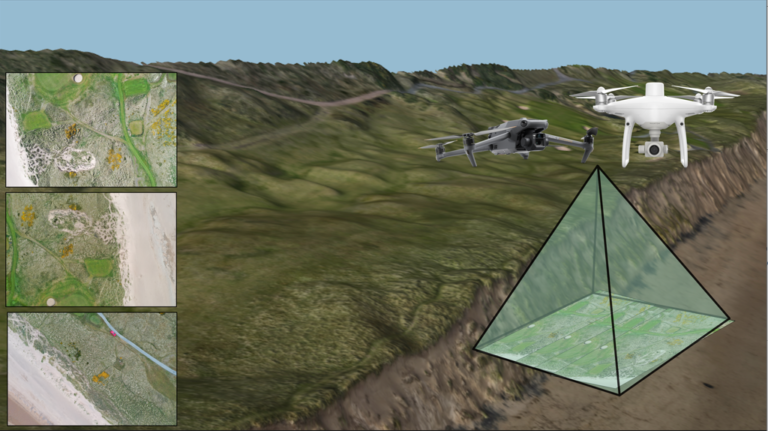Project Description
All coastlines are subject to dynamic change through wave and wind action resulting in significant loss or gain of land through erosion and/or accretion. Many areas around the World are increasingly being exposed to such threats resulting in partial or complete loss of assets in the most severe cases. In the future, climate change will likely accelerate the rate of coastline change with rising sea levels and more frequent and energetic storms.
Widespread evidence of climate change impacts on coasts around the world, when coupled with increasing demands being placed on dwindling management budgets, and the need to protect valuable coastal assets suggests the need for new, more cost-effective, approaches to local coastal management problems.
A focus on developing new, low-cost, and environmentally sustainable solutions will be important. This research project will design, model, implement and test a novel coastal engineering solution for the protection of coastal assets at risk, specifically golf courses. A hybrid-protection solution using sustainable materials bound into a flexible and tethered structure, allowing wind- and water-borne material to penetrate, and be captured by the structure, will be developed, and tested. This will be a low-cost structure easily installed, maintained, and managed at the local community level.
The proposed structure will need to be tested over time, in different locations, and under different conditions. To achieve this, the structure will first be modelled using mathematical engineering software. This will facilitate refinement of the design and permit testing of the structural integrity of the platform, its flexibility and any stresses exerted, and will help to optimise the physical structure for placement in different coastal locations. The final structure will be constructed using sustainable materials. A tethering system will also be designed to hold the structure in place.
Two structures are currently installed at Moray GC and Royal Aberdeen GC. Discussions are in progress for installation and testing at other sites in Montrose and NW England. Coastal modelling, wave over-topping and wave climate models (SWAN), as well as software MIKE21 and GIS will be used to appraise performance of existing and future structures using Multi-Criteria Analysis (MCA). In this way, data gathered from the installations will be used to optimise designs.
Testing of the structure will require in-situ monitoring. The potential for equipping the structures with onboard smart sensors to monitor stresses, strains and structural deformation over time is being pursued, whilst aerial drone camera sensors will be used to acquire aerial images and to generate mosaics and 3D models to establish environmental baselines. This will allow spatio-temporal changes to be monitored and the derivation of quantitative measurements (e.g. volumetric change) in the soft coastline both at and adjacent to the trial sites. This will provide valuable insight to the optimal design and positioning of coastal protection structures.
Training provision will include on-campus, in-situ and online training activities delivered in part by the supervisory and advisory team to provide background and contextual knowledge, understanding and expertise needed for the PhD candidate to undertake the research project.
CANDIDATE BACKGROUND
Essential skills: This is an applied geospatial research project requiring a combined background in environmental science/engineering and the geospatial sciences: with coastal engineering, modelling, programming, GIS, geostatistics, and remote sensing knowledge, understanding and expertise.
Desirable skills: An interest in the role of drones and their application is highly desirable, as is coastal and environmental management. Practical support/training will be provided by the University (AICSM, GIS, and UCEMM), DroneLite (drone company), the CASE partner and collaboration with R&A and local authorities.
Photo credit: David R. Green
Supervisors
David R. GreenPrimary Supervisor: | Profile: David R. Green Email: d.r.green@abdn.ac.uk Institution: University of Aberdeen Department/School: School of Geosciences |
Jennifer McKinleySecondary Supervisor: | Profile: Jennifer McKinley Email: j.mckinley@qub.ac.uk Institution: Queen's University, Belfast Department/School: School of Natural and Built Environment |
Dmitri MauquoyAdditional Supervisor: | Profile: Dmitri Mauquoy Email: d.mauquoy@abdn.ac.uk Institution: University of Aberdeen Department/School: School of Geosciences |
Additional Supervisor: | Dr. Brian Burnham – Senior Remote Sensing Scientist – APEM Ltd (https://www.apemltd.com/) (GIS, Visualisation, Data, Geology) |
References
Masselink, G., and Russell, P., 2013. Impacts of climate change on coastal erosion. MCCIP Science Review. 2013:71-86.
Fitton, J.M., Hansom, J.D., and Rennie, A.F., 2016. A national coastal erosion susceptibility model for Scotland. Ocean & Coastal Management. Volume 132:80-89.
Dynamic Coast: https://www.dynamiccoast.com/
QUADRAT Themes
- environmental-management
Partners
CASE Partnership confirmed with Siskin Asset Management and R&A
A CASE Partnership project is delivered in collaboration with an industry partner. The CASE partner organisation contributes finance, expertise, facilities and an internship.






















































